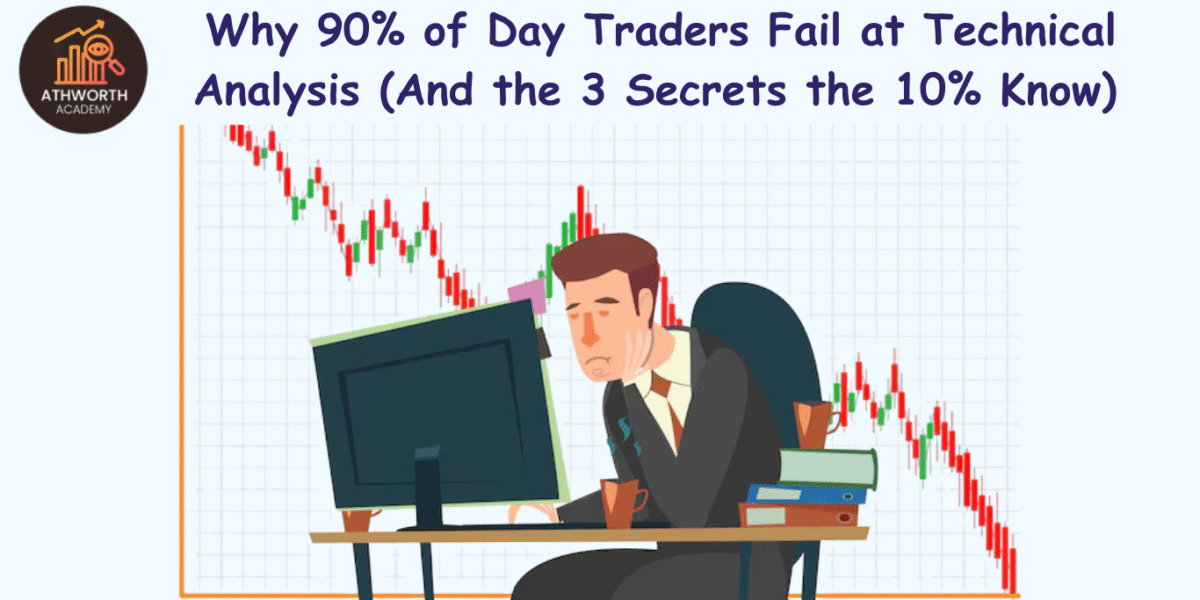If you’re nodding your head right now, you’re not alone. Statistics show that a staggering 90% of day traders lose money, & most of them fail specifically because they misunderstand technical analysis. It’s not that technical analysis doesn’t work – it’s that most people are doing it all WRONG. They’re focusing on the flashy indicators & complex patterns while missing the fundamental principles that actually matter.
This isn’t another article promising you a magic formula or a secret indicator that will make you rich overnight. Instead, we’re going to pull back the curtain & reveal why the majority of traders fail at technical analysis, & more importantly, what separates the successful 10% from everyone else. We’ll explore the three crucial secrets that profitable traders know but rarely share, & how you can apply these insights to transform your own trading results. Get ready to discover why your current approach might be sabotaging your SUCCESS before you even place your first trade.
The Harsh Reality: Why Most Traders Fail at Technical Analysis
The truth about technical analysis failure isn’t pretty, but it’s necessary to understand. Most traders approach technical analysis like they’re trying to solve a complex puzzle with pieces from different boxes. They load their charts with dozens of indicators, each flashing different signals, creating a chaotic mess of conflicting information. Imagine trying to drive a car while looking at ten different GPS systems all giving you different directions – that’s exactly what most traders do to their charts.
The biggest mistake? Believing that more indicators equal better results. New traders often suffer from what experts call “indicator overload syndrome.” They’ll have moving averages, RSI, MACD, Bollinger Bands, Fibonacci retracements, & countless other tools all crammed onto a single chart. When the market moves against them, they don’t blame their strategy – they just add MORE indicators, hoping the next one will be the magical solution. This creates a vicious cycle where traders become paralyzed by conflicting signals & end up making emotional decisions instead of logical ones.
Another critical failure point is the misunderstanding of what technical analysis actually represents. Most traders think technical analysis predicts the future, but successful traders know it simply identifies PROBABILITIES. When you see a “bullish” pattern, it doesn’t guarantee the price will go up – it just suggests there’s a higher probability of upward movement based on historical patterns. This fundamental misunderstanding leads to overconfidence & poor risk management, two deadly combinations in trading.
The final nail in the coffin is the lack of proper backtesting & statistical thinking. Most failing traders see a pattern work once or twice & immediately assume they’ve found their golden ticket. They don’t test their strategies on hundreds of trades over different market conditions. They don’t calculate their win rates, average profits, or maximum drawdowns. Instead, they jump into live trading with real money based on limited observations, which is essentially gambling with extra steps.
Secret 1: Context is Everything – Reading the Market’s Mood
Here’s the first secret that separates winners from losers: successful traders don’t just read charts, they read the market’s EMOTIONAL state. Think of technical analysis like reading body language – a smile might mean happiness, but if someone is crying while smiling, you know something deeper is happening. The same principle applies to market patterns & indicators.
The 10% of successful traders understand that every technical pattern must be interpreted within its proper context. A breakout pattern during high volume with strong market momentum carries completely different implications than the same pattern during low volume in a sideways market. Most failing traders see the pattern & immediately assume it will behave the same way every time, ignoring the surrounding CONDITIONS that determine its effectiveness.
Market context includes several layers that most traders completely ignore. First, there’s the overall market sentiment – are we in a bull market, bear market, or sideways grind? The same technical setup that works beautifully in a trending market might fail miserably in a choppy, range-bound environment. Second, there’s the sector rotation & industry-specific factors. A perfect technical setup in a declining sector might be fighting against stronger fundamental currents.
Volume is another crucial contextual element that most traders treat as an afterthought. Successful traders know that volume is the fuel that powers price movements. A breakout with heavy volume suggests strong conviction & follow-through, while a breakout with weak volume often leads to false signals & whipsaws. Think of volume as the difference between a whisper & a shout – both convey the same words, but the intensity tells you how seriously to take the message.
Time frame context is equally important but often overlooked. A bullish signal on a 5-minute chart means nothing if the daily & weekly charts are screaming bearish. The 10% of successful traders always check multiple time frames to ensure their trades align with the bigger picture. They understand that fighting against higher time frame trends is like swimming against a powerful current – you might make progress temporarily, but you’ll eventually get swept away.
Secret 2: Probability Management Over Prediction Addiction
The second secret that successful traders understand is perhaps the most counterintuitive: they’re not trying to predict the future, they’re managing probabilities. While 90% of traders obsess over being RIGHT about market direction, the profitable 10% focus on being PROFITABLE over time. This fundamental shift in mindset separates professionals from amateurs more than any technical indicator ever could.
Successful traders approach each trade like a casino approaches each bet. They know that individual outcomes are unpredictable, but they also understand that if they maintain a statistical edge over many trades, they’ll be profitable in the long run. This means they’re perfectly comfortable losing on 60% of their trades if their winners are significantly larger than their losers. Most failing traders can’t psychologically handle this approach because they’re addicted to the dopamine hit of being “right” about market predictions.
The probability management approach requires strict adherence to position sizing & risk management rules. Successful traders never risk more than 1-2% of their account on any single trade, regardless of how “certain” they feel about the outcome. They understand that even their best setups fail sometimes, & they’re prepared for that reality. In contrast, failing traders often risk 10-20% or more on trades they feel confident about, which leads to catastrophic losses when they’re wrong.
This secret also involves understanding & accepting the random nature of short-term price movements. The market can stay irrational longer than most traders can stay solvent, & successful traders build this reality into their strategies. They don’t abandon their approach after a few losing trades because they understand that losing streaks are a normal part of probability-based trading. Instead, they focus on executing their strategy consistently & letting the statistical edge play out over time.
Risk-to-reward ratios become paramount when you’re managing probabilities instead of making predictions. Successful traders typically aim for trades where they can make $3 for every $1 they risk, even if these trades have a lower win rate. This mathematical approach ensures profitability even when they’re wrong more often than they’re right. Most failing traders do the opposite – they take quick profits when they’re winning & hold losing positions hoping they’ll turn around, which destroys their risk-to-reward ratios.
Secret 3: Emotional Mastery & Systematic Execution
The third & perhaps most crucial secret is that successful traders treat trading like a BUSINESS, not a hobby or gambling activity. They understand that emotions are the enemy of consistent profits, & they’ve developed systematic approaches to minimize emotional decision-making. While most traders rely on gut feelings & impulses, the profitable 10% follow predetermined rules & systems religiously.
Emotional mastery starts with accepting that losses are simply a cost of doing business. Successful traders don’t take losses personally or let them affect their confidence in their strategy. They understand that each loss brings them closer to their next winner, assuming they’re following a statistically sound approach. This mindset prevents them from revenge trading or abandoning their strategy after a few bad trades, which are common reasons why most traders fail.
The systematic execution aspect involves creating detailed trading plans BEFORE entering positions. Successful traders know exactly where they’ll enter, where they’ll exit for a profit, & where they’ll cut their losses before they click the buy button. They don’t make these decisions in real-time while emotions are running high & money is on the line. Most failing traders wing it, making crucial decisions when they’re least equipped to think clearly.
Documentation & continuous improvement are also hallmarks of systematic traders. They keep detailed records of every trade, including screenshots of their setups, reasons for entering, & lessons learned from each outcome. This allows them to identify patterns in their own behavior & continuously refine their approach. Most losing traders never analyze their past trades, so they keep making the same mistakes repeatedly.
The final component of emotional mastery is understanding the psychological phases of trading. Successful traders recognize when they’re in a state of overconfidence after winning streaks or fear after losing streaks, & they adjust their behavior accordingly. They might reduce position sizes when they’re feeling overconfident or take a break when they’re feeling fearful. This self-awareness prevents them from making emotional decisions that could derail their long-term success
The Path Forward: Transforming Your Trading Approach
Now that you understand why 90% of day traders fail & what the successful 10% do differently, it’s time to honestly evaluate your own approach. Are you guilty of indicator overload? Do you focus more on being right than being profitable? Have you developed the systematic approach & emotional control that successful trading requires? These aren’t easy questions to answer, but they’re essential for your trading evolution.
The transformation from failing trader to successful trader doesn’t happen overnight. It requires a fundamental shift in how you think about markets, risk, & your own psychology. Start by simplifying your approach – remove unnecessary indicators & focus on understanding market context. Develop a probability-based mindset where you’re comfortable with uncertainty & focus on managing risk rather than predicting outcomes.
Most importantly, treat this as a professional development journey, not a get-rich-quick scheme. Study the successful traders who came before you, backtest your strategies thoroughly, & develop the discipline to follow your rules even when your emotions are screaming otherwise. Remember, the market doesn’t care about your feelings or your financial situation – it only responds to those who approach it with the proper knowledge, skills, & mindset.
The difference between the 10% who succeed & the 90% who fail isn’t intelligence or luck – it’s the willingness to do what others won’t. Are you ready to join the ranks of consistently profitable traders, or will you continue making the same mistakes that keep most people trapped in the cycle of losses? The choice is yours, but now you have the roadmap to make it happen.

